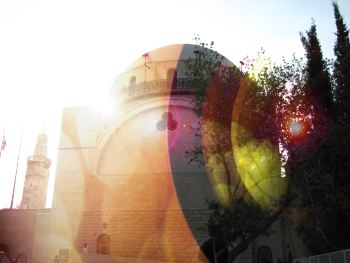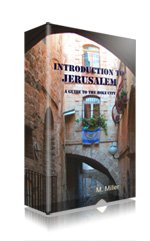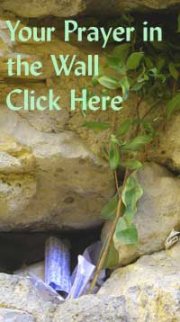Golgotha and the Holy Sepulcher
Golgotha - the name alone is evocative. Anyone who comes to Jerusalem interested in Jesus history will want to follow the Via Dolorosa to its end: the Holy Sepulcher, Christianity’s holiest site.
The place where tradition says Jesus was crucified, and the cave where he was buried are contained withing the sprawling church of the Holy Sepulcher.
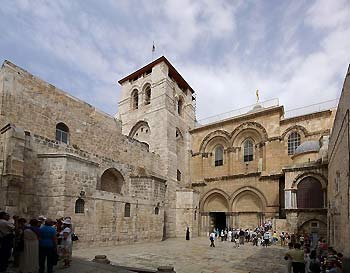
Holy Sepulcher entrance. Photo by B. Werner under a cc-by-3.0 license.
Archaeologists agree that, while they may never know for sure, there is a lot of evidence that this was, indeed, the place where Jesus was buried. As such, this is one of the most holy sites in Christendom.
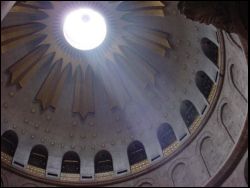
Records show the Christian community of Jerusalem prayed at the site as early as 66 C.E. Although Hadrian later built a temple to Aphrodite here (possibly to erase the Christian connection), the Emperor Constantine razed the temple to build a church here in 326 CE after his mother, Helena came to Jerusalem and identified the site as Golgotha, where Jesus was crucified.
Constantine’s church was almost completely destroyed in 1009 CE by the Muslim Caliph Hakim, which sparked the First Crusade. The present building is smaller than Constantine’s and its Romanesque-style core dates to the Crusaders, who dedicated the new building in 1149.
Today, the church is strictly divided among various Christian sects, who, unfortunately, regularly come to blows over what belongs to whom. The Roman Catholic, Greek Orthodox and Armenians rule over most of the church, while smaller parts “belong” to the Copts, and Syrian and Ethiopian Orthodox churches. The status quo strictly determines times of prayer for each group, the lighting of candles, even on which floor tiles members of which community may step.
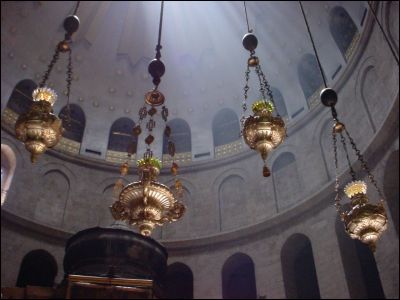
This is one place best visited with a tour guide or detailed guide book, for there is a lot to see. Without someone to explain it all, though, it can look like just one huge mishmash, where Byzantine, medieval, Crusader elements clash with no rhyme or reason. It would be a shame to leave disappointed from what could otherwise be a deeply meaningful experience.
And you might miss little details like this one: At the entrance to the church, you can see a ladder. Until 1831, the Muslim rulers only allowed the church doors to open on holidays. The rest of the year, the Christian monks who lived here were under house arrest. Their food was brought to them up this ladder and through the window. Because the ladder is part of the ancient status quo between the sects, no one is permitted to move it, even though it isn’t used any more.
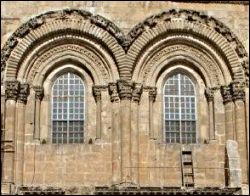
Note the ladder in the lower right hand side.
The main attractions in the church are Golgotha, where you’ll find Stations of the Cross X, XI, XII and XIII, the Tomb of Jesus, and the Chapel of St. Helena, where tradition claims Helena found the true cross.
But you might also find some of the lesser know sites interesting too:
- The chapel of Adam was a favorite burial place of Catholic Crusader kings. Mark Twain was particularly moved by his visit to what Catholics claim is Adam’s burial place, noting, with dubious logic, that there was no question this was Adam’s grave because no one had ever proven that it was not Adam’s grave. (He must not have asked the Jews, who believe Adam and Eve to be buried in the Cave of the Patriarchs in the city of Hebron.)
- Deir Al-Sultan is a village of huts on the roof of the Chapel of St Helena. Ethiopian monks live here, although the site is hotly contested by the Copts. An Israeli court ruled in favor of the Ethiopian community, but the Egyptian government regularly raises the issue (most Copts live in Egypt), requesting the transfer of the compound to the Coptic church.
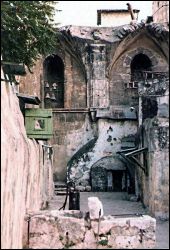
Deir Al-Sultan Ethiopian compound on the roof of the Chapel of St. Helena
- Near the entrance to the church you might notice a wooden panel (to your right as you walk in). This is the tomb of Philip d’Aubigne, the tutor of Henry III of England, whose signature appears on the Magna Carta. He requested to be buried here so that pilgrims would tread over his grave.
- In the Golgotha area, opposite Station XI, is an altar whose base is made of bronze lattice work. This lattice was made by Giovanni da Bologna, a Flemish artist who worked in Italy. It was donated to the church by the Medici family in 1588 and is one of the most valuable artistic treasures in Israel.
Golgotha and the Holy Sepulcher > Jerusalem Holy Sites
Via Dolorosa and the Christian Quarter
Jerusalem Home page
Don't Miss What's New in Jerusalem!
Stay up-to-date with all that's new in Jerusalem and on this site. Subscribe to the RSS feed at the top of the navigation bar over on the left and you won't miss a thing.
And sign up for our free monthly newsletter to stay abreast of what's
going on, as well as new discoveries, seasonal events, cool Jerusalem tours and
exciting activities.
Subscribe to Our Newsletter
"As we had limited time in Jerusalem, I purchased your mini guide book and found it very informative. Thanks!" - Brian, S. Africa

Click here for the top 5 discount hotels in Jerusalem.
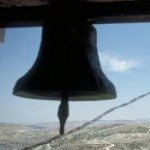

Recent Articles
-
Jerusalem of Gold: the Unofficial Anthem of Israel
May 22, 20 06:16 AM
-
Jerusalem Vacation Rentals
May 31, 19 09:46 AM
Jerusalem Video
6-min virtual tour

